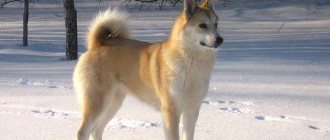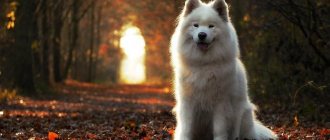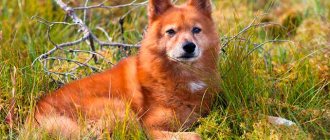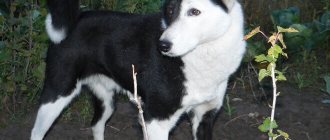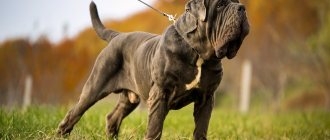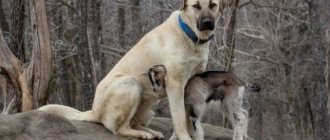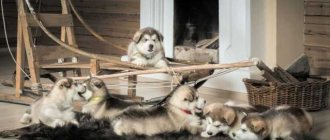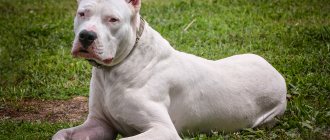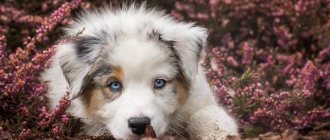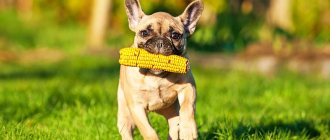Description and features
Experts draw data on the history of the origin of various ancient dogs from chronicles. Unfortunately, nothing was preserved about the West Siberian Laika breed However, it is claimed to be one of the oldest dogs in the world, with a history of discovery dating back more than 1,000 years ago.
According to the most common opinion, in Ancient Rus', huskies were exploited as ordinary yard animals guarding buildings and livestock. Men also often took them with them hunting. This is due to the versatility of the breed. Its representatives actually perform many functions, from companionship to hunting.
Let's take a closer look at the last function. Laika is not only hardy, but also very strong and fast. She is capable of catching up with a deer, elk or even a ferocious boar in dense terrain. A dog that is not bloodthirsty by nature, of course, cannot win a fight with the last beast, so it hunts only in pairs with its owner. What also makes this dog versatile is its ability to catch swamp animals.
It is better that the owner of such a pet, who goes hunting with him into the forest, has a gun with him. In the forests of Siberia, where huskies are most often exploited for this purpose, there are many wild ferocious animals that can be the first to attack a dog, crippling it. Therefore, it is not advisable for her owner to go there with her without having a weapon.
Further. The representative of the breed is an adequate and reliable watchdog. He deservedly takes his place in this career niche. Trains well and quickly, is open to new information, and easily assimilates it.
As for sociable inclinations, the West Siberian Laika definitely has them. The animal quickly gets used to the house, the people who live there, and strives to protect them at all costs. Loves everything new. At home, he regularly explores the territory and strives to please himself by searching for interesting objects. The curiosity and activity of huskies knows no bounds.
The owner of such a pet must always remember this. An unemotional life will make such a dog unhappy. She is bright and energetic, so she needs regular feeding with new things. We are talking about the need for frequent walks with her, meeting different people and animals, buying beautiful toys for her, etc.
History of the breed and its psychological portrait
As you know, the West Siberian Laika was bred on the basis of 2 breeds. In the 20th century, cynologists from Russia created standards for huskies. Most likely, the formation of the breed would have been impossible if specialists had not selected animals for the best hunting qualities: endurance, speed, developed hearing, vision and scent.
The brave dog will become an excellent companion to the owner and an excellent hunter. The dog quite quickly becomes attached to the person who raises him. From loneliness, a dog whose color is very beautiful can get sick. Therefore, she needs to pay maximum attention.
The pet is kind and balanced. He is good with small children. However, the Siberian character makes itself felt. The dog can become aggressive when provoked for a long time. Very often, males have a desire to dominate among dogs.
As you know, the West Siberian Laika was bred on the basis of 2 breeds. In the 20th century, cynologists from Russia created standards for huskies
Having chosen this breed, you need to be prepared that huskies are very active, and you should work with them every day and teach them commands. This way, the dog will not accumulate excess energy.
Breed standard
The West Siberian Laika dog is a medium-sized breed, although some experts classify it as large. The dog's physique is proportional, he is well built. It is believed that it was selected for many years. Ancient representatives of the breed were much larger than modern ones.
However, their massiveness deprived them of such an important skill necessary for hunting as agility. According to the standard, the weight of a normal representative of the breed should not exceed 20-23 kg. Some young females weigh 15-15 kg and this is not a deviation. The height of an average-sized individual is 58-60 cm.
It must be said that the above parameters are not so important for the judicial analysis of the West Siberian Laika. Experts evaluate this animal, first of all, by the harmony of its body parts, that is, they analyze how well it is built.
The dog's body is elongated. The neck is not long, has a barely noticeable bend. The ribs are not visible at all on the muscular, broad back. The withers are perfectly expressed. The chest is not wide, not protruding. On strong and symmetrically placed legs, the knee joints are well defined. The tail is ring-shaped, most often lies on the back, but can hang to the side.
The wedge-shaped head is slightly elongated. The transition to the muzzle is smooth. The dog's jaw is tightened, his lips are dry, his teeth are snow-white and strong. According to the standard, the bite of a purebred husky should be scissor-shaped.
His ears are triangular, have pointed corners, and erect. The nose is large, pigmented, often black. The look of the West Siberian Laika in the photo is expressive and interested. Her almond-shaped eyes are set shallowly. Their shade is black or dark brown.
All dogs bred in Siberia have a dense undercoat. It performs an important protective function of insulation. The animal is not afraid of frost and blizzard. The dog's fur grows straight, vertically in relation to his body, this gives the impression that he has a fluffy fur coat.
The dog's appearance is really bright and elegant. There are a lot of colors. Popular options:
- Pure white.
- Sandy brown.
- Pure brown.
- Ginger.
- Red-gray.
- Black and white.
Choosing a pet
Before you start looking for a puppy, you should determine why you need a dog. Do you need a hunter or a good companion? If you decide that you need a hunting dog, then puppies should be purchased from the best breed of Laikas. The puppy's parents must have the following breed characteristics:
- oblique eyelid incision;
- erect ears;
- Brown eyes;
- sharp muzzle with dark nose;
- fluffy tail;
- soft undercoat;
- The spine is straight and hard.
A very good sign in the ZSL is the presence of a tail, which is wrapped in a ring.
The pet is kind and balanced.
It must be remembered that an animal of this breed develops very quickly. That is why it is better to buy a dog at the age of 4 weeks. One should already have ears in the shape of a triangle, a gentle transition from the forehead to the muzzle, and there should be no folds on the lips.
Character
If you have read or heard somewhere that the West Siberian Laika is a very kind and tame pet, you should know that you have been misled. This thesis is only partly true. There is something wild in the character of such an animal; it is not for nothing that its appearance resembles a wolf.
No, it is definitely possible to tame this dog, but do not expect it to serve you, like, for example, a Labrador or a German Shepherd. This animal is distinguished by its willfulness, some obstinacy and self-confidence. It is recommended to build a partnership relationship with him. What does this mean?
As an assistant and unquestioning servant, such a dog is ineffective. But as a comrade helping to complete a task that is interesting to him, it’s the opposite. Partnerships provide for mutual benefit. The owner gives his pet shelter, takes care of him, trains him, and he, in turn, protects his home, goes on a joint hunt and gives love and tenderness.
Despite their pretty appearance, none of the famous huskies can be called absolutely good-natured. She can snap if any living creature, even a person, begins to behave too intrusively. Being in a bad mood (and this happens periodically with these beautiful dogs), he moves away and spends time alone. Needs personal space.
Not prone to strong excitability. Almost always behaves appropriately. Loves order and certainty, cannot stand chaos. In principle, the Laika is a good and positive dog that easily becomes attached to its owners. She loves to sleep at their feet, spend time together, but most of all she likes going to the forests together.
In densely growing areas it can demonstrate all the hunter’s talents given to it by nature. For example, there are cases when a representative of this breed, at the time of a foray, disappeared into the forest for some time, after which he brought a killed bird or fish to his family members.
Another interesting feature of West Siberian huskies is their flexible intelligence. The ability to make decisions independently and learn quickly are the things that make a dog valuable, and the representative of the breed in question has them.
Well, excellent working potential is passed on to him genetically. Modern West Siberian Laikas are in no way inferior to their ancient and more massive ancestors. They are clever, fearless, inquisitive and very loyal.
It is also worth highlighting a few more specific aspects of the character of such dogs. They truly hate most species of animals. This is due to well-developed hunting instincts. However, thinking that this applies to people is a mistake. Although, they often react warily to suspicious strangers.
The interesting thing is that these wonderful dogs are monogamous. In the world of living nature, this concept extends to those who remain faithful to one living creature. The West Siberian husky will never change its owner; once it becomes attached to a person once, it will remain faithful to him all its life.
Key points in training
It is necessary to train a puppy as soon as it is brought to its new home, because this breed is quite stubborn. We must immediately show who is in charge.
Training usually begins at about 10 months. Training begins with basic commands. Laikas are highly trainable. This is due to the habit of unquestioning obedience to the owner .
If the dog's owner is a hunter, then training is best carried out at special sites. Here the pet can get used to the light from the car headlights, the sound of gunshots and learn a lot of things that are necessary during the hunt.
Read about how to properly train a dog in the article: “Training a puppy: effective methods from dog handlers, learning commands at home.”
Care and maintenance
Keeping it in a yard or a spacious enclosure is the best option for a representative of the breed. They will be uninterested and completely joyless living in the same apartment with the owners. This is a skittish breed, prone to mood swings, so sometimes it needs to be alone.
If you live with a husky in the house and keep it outside, do not forget to go out to spend time with it every day, it is better to do this several times. Also, do not ignore her natural need for walking.
Yes, a dog can relieve itself outside, but it also needs walks to gain new sensations. Don't deprive your pet of the opportunity to explore the world the way he wants. Give him freedom.
Laikas are not prone to self-indulgence or distracted behavior, so they will not run away if you let them off the leash. But, if there are other dogs nearby, it is better not to let the animal go, as it will certainly start a conflict with them.
What you definitely shouldn’t do is put a husky on a chain! This proud Siberian dog will not faithfully serve a man who will limit his freedom so much. Moreover, such a life will make the animal as unhappy as possible.
About care. The first thing you should pay attention to is the dog's fur. In huskies it is lush and straight, well protected from contamination. However, it is recommended to clean it once a year. Without this, the animal begins to smell unpleasant. Which shampoo to choose? You should buy a special detergent for your dog from a pet store. You cannot wash it with human hair shampoo.
Unfortunately, representatives of the breed often face such an unpleasant problem as tartar. It forms on the surface of his fangs. The best prevention is regular mouth cleaning.
Of course, your dog will not be able to brush his teeth on his own, no matter how smart he is. Therefore, he will need your help. In addition to regular oral brushing, give your pet soft bone cartilage regularly. This will help him get rid of tartar and plaque.
Ears are one of the most vulnerable places of a husky. They are often exposed to infections and parasites, especially if she regularly hunts in the forest. They should be inspected every week. You need to wash your ears regularly, but it is important to make sure that water does not flow into them!
Use a cotton cloth or cotton wool soaked in warm water to wipe their surface. It is also necessary to monitor the condition of your pet's eyes. They should not be sour or inflamed. Wash his face.
You should sharpen your dog's claws only if, for some reason, he does not do it on his own. Most active and nimble huskies do not need this procedure.
Caring for your husky
The breeds were bred for the harsh northern climate; heat has a negative impact on the dog’s health.
During shedding, the coat should be combed twice a week with a stiff comb. At other times, the husky itself will monitor it. She is very clean.
Bathe your dog only when necessary. Otherwise, the beautiful “fur coat” will become dull and the natural fat will be washed away. Swim only with air conditioning.
The eyes never become sour; for prevention, it is permissible to wipe with a damp cloth.
Inspect your ears regularly, wipe the ears with a damp swab 2 times a month to prevent wax from accumulating.
Claws. If the dog leads an active life (running or hunting), they will wear off on their own. Otherwise, you will have to prune once every few months.
Inspect the dog's paws, avoid cuts and abrasions. Wipe paws with a damp cloth after going outside.
Nutrition
A ready-made diet (dry food) is perfect for the West Siberian Laika. She should eat at least 800 grams of this product per day. Don't skimp on it! Buy only premium food. How to distinguish good dry food from bad? Answer: by composition. In a quality product, the main ingredient should be meat.
If your pet is fed dry food, periodically feed it with offal, fortified foods, for example, berries or vegetables, bone cartilage, fermented milk, etc. What definitely should not be included in its menu:
- Fatty foods cooked in oil.
- Pastries, cream cakes.
- Expired products.
- Fat cottage cheese.
- Stewed lamb or pork.
- Fatty fish with bones.
- Chocolate and marmalade.
Remember, your husky should eat plenty of vitamins at any time of the year, so never deprive her of the pleasure of eating a banana in winter or a fresh tomato in summer.
Reproduction and lifespan
West Siberian huskies live on average 13 years. These are hardy and energetic dogs that are adapted to live in conditions of low temperatures, strong winds, frosts, etc.
The breeder must know all the requirements for representatives of the breed, outlined by the standard. He must select candidates for mating, firstly, who are sexually mature, who are older than 2.5 and younger than 7 years, and secondly, who are adequate in behavior.
Healthy and healthy offspring will be produced by calm and good-natured dogs that show sexual interest in each other. The bitch should not be aggressive towards the male, otherwise it will not happen.
If her behavior is too aggressive, the meeting is postponed. Probably, after meeting this male the day before, she will become more accommodating towards him.
In order for the mating to definitely end in conception, it is advisable to introduce the male to the female in the middle of her estrus period, approximately 3 days after its start. Within 67-70 days after this, puppies will be born.
Price
Where is the best place for a dog owner to buy a pet? Of course, in the nursery. In this place he will definitely not be deceived; he will be provided with all the documents, from a passport to a pedigree, and will be taught how to raise, care for and treat a dog. This purchase is also good for long-term cooperation.
Most kennels of purebred dogs provide a guarantee on them. This means that in the first year after purchasing an animal there, you receive long-term assistance in caring for it.
No, an employee of this institution will not come to your home to comb your dog, but he will certainly advise you over the phone on this issue and many others. The average price of the West Siberian Laika in Russia for 2022 is 15 thousand rubles.
Puppies
Choosing a pet is not an easy task, since the husky is a whole group of breeds with significant differences. First you need to decide for what purpose you are getting a dog. If an attractive exterior is a priority for the owner, then you should choose a puppy based on its external characteristics.
If a husky puppy is purchased for hunting, then appearance alone is not enough. Without skills in the basics of dog breeding and knowledge of the peculiarities of keeping the breed, it will not be easy to manage huskies, since they are distinguished by their freedom-loving character and independence. This breed is absolutely not suitable for homebodies, opponents of hunting and lovers of silence.
There are often cases when a person who does not have training skills acquires an adult dog. This is not recommended. Laikas are monogamous people who remain devoted to their first owner until the end of their lives; they will not be able to accept the new owner and will not obey him.
The best option for choosing a puppy is to contact practicing hunters or a well-known nursery, where the future owner is required to show the documents for the puppy and the working diplomas of the parents.
The decisive factor in the choice is the character of the student. A Laika puppy should be cheerful, playful and healthy. It is better for a hunter to choose a medium-sized puppy. You can take your pet home at the age of one and a half months.
Education and training
All service dog breeds need a leader, that is, a leader. Do not forget that the dog is a pack animal that should be socialized in a group and led.
A husky prone to dominance can snap, steal food from the table, bite other animals in the house, sleep anywhere, that is, be a problem for the family. Unfortunately, representatives of this breed are often abandoned. But, with proper upbringing, they become quite adequate and well-managed.
We advocate that anyone can learn to raise a service dog correctly, without professional help. Laikas are by nature inquisitive, trusting, but a little wild.
From this it follows that for successful training they should be interested. The best option is to give the animal a treat. Give the animal the opportunity to gain confidence in you, let it associate your voice and hands with “yummy.” Then it will definitely listen to you.
The first thing you should teach such a dog is to remember his name, that is, his nickname. Let each family member call him by name, call him to him, and then good-naturedly pat him on the withers or head. Giving a treat in this case also won’t hurt.
When the dog remembers its name, start training basic commands: give paw, lie down, no, sit, etc. There will be no specific recommendations here, the main thing is to hone the dog’s skills to the point of automaticity, and this requires a lot of practice.
Training with a leash and collar is equally important. This is the standard home equipment needed to train the West Siberian Laika. A leash is a visible connection between a man and his dog. The first determines how durable and long-lasting it will be.
In order for your dog to approach you with pleasure, you should not shout at him; let him associate the collar and leash with an interesting walk. But before she goes outside the house, she must get rid of her excitement.
A common mistake made by inexperienced dog owners is going out with an excited dog. Most four-legged pets get very happy at the sight of a leash and do not calm down for a long time. Going out into the yard with them means encouraging an unstable mental state. First, you need to give the animal the opportunity to calm down and only after that, walk it.
Other equally important rules for raising huskies:
- Scold and shame her for damaging interior items. Poke the dog’s muzzle into the thing that has been damaged, and then isolate it from yourself.
- Do not allow people to relieve themselves indoors. It is important to teach a West Siberian husky puppy to look for a latrine only outside, and in any weather.
- You should not allow your animal to jump on your home furniture.
- Control the process of his acquaintance with cats, mice and other animals in the house.
- Do not allow him to develop food aggression (roaring during meals). If your dog gets angry while eating, gently toss something tastier into his bowl, such as cheese. This will stop her from associating you with a threat. Your hands will become a pleasant symbol for her.
History of the origin of the West Siberian Laika
West Siberian Laikas are descended from aboriginal hunting dogs that have lived in Siberia beyond the Ural Mountains since ancient times. Until the 20th century, many huskies of mixed breeds lived in the taiga, but from village to village they all had their own special features. Local hunters used them during their forays for game.
Of course, there could be no talk of dividing breeds then, because dogs crossed absolutely freely, and people selected the most “successful” puppies. Only by 1939 did specialists become seriously concerned about sterilization and targeted breed restriction: their attention was primarily attracted to Mansi and Khanty dogs. They performed better than other breeds during the hunt. In the same year, a meeting of Soviet dog handlers established five breed types. Among them were likes.
They took control of the breeding of huskies only in the 40s of the same century - the reason for this was the necessity declared by the state. With the outbreak of the war, the country needed money, the source of which could be meat and furs. Hunters from Siberia, along with their four-legged helpers, set out to extract these resources. The then famous kennel “Krasnaya Zvezda” took up the task of popularizing the breed, but most of the dogs at that time came from kennels in the Perm and Novosibirsk regions.
Laikas were classified only in 1947 on the initiative of E.I. Shereshevsky. Then the Khanty and Mansi dogs were combined into one West Siberian breed. Although this proposal was not accepted immediately, after 5 years the hunting breeds were replenished with three new ones, among which was the West Siberian. By the years 60-70 it was already quite popular in the USSR, and after another 10 years it was recognized by the FCI. Since then, West Siberian Laikas have been allowed to participate in international exhibitions.
Possible diseases and methods of treating them
The West Siberian Laika has no hereditary diseases. However, even these strong dogs end up at the veterinarian's office with dislocated and broken legs. Typically, limbs are damaged only by those individuals that regularly hunt in the forests with their owners.
There are practically no preventive measures aimed at minimizing the risk of injury to limbs during hunting. It is important to take your dog to the hospital in a timely manner if he tightens his limb and whines loudly. These symptoms clearly indicate injury.
To keep your dog healthy, be sure to check his teeth, eyes, and ears regularly. They will have to be systematically looked after. And, of course, improve your pet’s health with vitamin complexes for animals.
Appearance
Judging by the photo of the East Siberian Laika, they are:
- white;
- red;
- black;
- gray-brown;
- black and piebald.
Standard characteristics of purebred individuals:
- Large body with impressive bones. Slightly oblong in shape.
- The head is wedge-shaped, wide and rounded skull.
- Smooth lines of the muzzle.
- Triangular ears are in a standing position.
- Medium sized oval eyes. Slightly slanted, different shades of brown.
- The lips are even.
- Powerful jaw grip.
- Medium sized muscular neck.
- Well developed withers. Along the line of the back it is noticeable in volume.
- Curled tail.
- Straight back line.
- The paws are muscular and positioned proportionally.
- Hard hair. Dense undercoat. The hair on the head is short and gathers into a collar on the neck.
